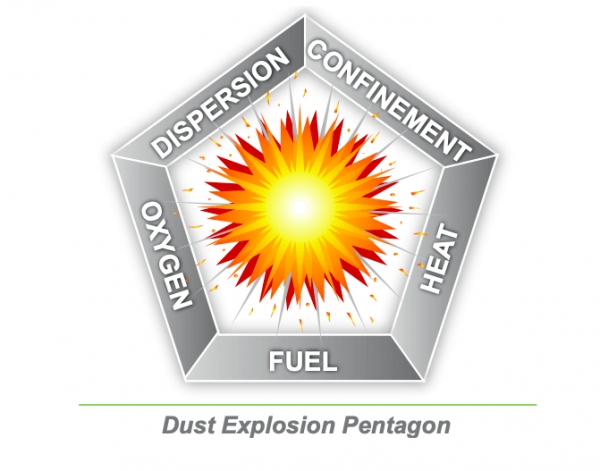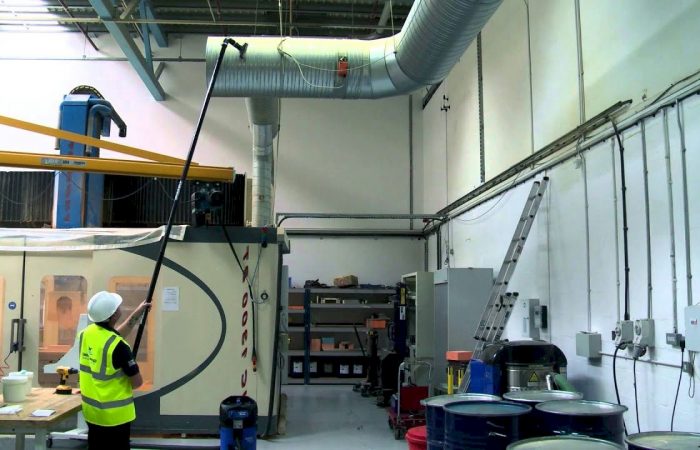Cleaning Hard to Reach Spaces in Your Industrial Facility
While dust accumulation in your facility may seem like a minor safety concern insofar as cleaning is concerned, it can pose serious health and safety risks if handled improperly. This is especially true when combustible dust collects overhead and in other hard-to-reach places. When fugitive combustible dust becomes suspended in the air in a confined area with sufficient concentration, it can quickly become a recipe for a dust explosion.
In order to meet increasingly stringent safety regulations, these overhead locations must be thoroughly cleaned, a process that typically requires specialized high-reaching housekeeping tools such as pipe brushes and extension wands.
Why Cleaning a Facility Is Important
In an industrial facility, any mess can become a safety hazard, no matter how small or insignificant it seems. This is especially true with dust, which can quickly become combustible under the right conditions and in the right environment.
Combustible dust comes in many forms, from food dust like sugar and flour dust to metal dust and powder. When dust comes into contact with oxygen, heat and a fuel source, a fire can occur; and when that dust is dispersed in a confined space, it can lead to a potentially deadly explosion.

If there is combustible dust in a facility, the risk of fire and explosion is much greater. As a result, there is a higher chance of accidents, worker injuries, and even possibly death.
If any incidents occur, not only can your business find itself subject to a Worker’s Compensation lawsuit, but you can also count on being subjected to a Health & Safety investigation. This means that your business may have to suspend operations while the investigation occurs and, if found at fault, could be subjected to further fines and penalties.
2. Keeps Employees Healthy
Without implementing proper housekeeping procedures, your facility can become an unhealthy environment for your employees. Dust, mold, chemicals and other forms of contamination can collect on surfaces and spread throughout the facility.
When dust is present in the air, it can land on the skin or be inhaled. This can lead to skin issues, respiratory problems and even allergies, and these health issues can worsen over time. While all dust can lead to these types of issues, it’s the fine dust often found in industrial facilities which pose the greatest risk.
3. Increases Productivity
Maintaining a clean industrial facility also has the potential to increase employee productivity. When routine housekeeping procedures are followed, employees spend less time cleaning the facility before starting their work shift. A clean facility can also create an environment where workers are safer and happier and, as a result, are more efficient in meeting their responsibilities.
A clean facility is an organized facility. Your workers will not struggle to find their equipment or materials — and clean them once found — which translates into work getting done easier and faster.
4. Maintains a Well-Functioning Facility
When a facility isn’t clean, not only is it unsafe and unsanitary, but it also won’t run properly either. A dirty facility can lead to mechanical issues with equipment, where tools move slower or break down completely.
Dust, in particular, can be problematic as fine dust particles get between gears and moving parts and cause them to stop working.
Because fugitive combustible dust poses a fire or explosion risk in the right environment, it is critical to have the right tools to reach all areas that may accumulate dust. With an extension wand, curved brushes and small, round utility brushes, you can clean the taller machines, corners, overhead beams and pipes. All of these areas are prone to fine dust accumulation.
Common Cleaning Issues In Industrial Facilities
Most industrial facilities have a cleaning plan in place already. However, it may not be sufficient or meet all of the legislative requirements, which become more stringent every year. In some cases, the housekeeping procedure currently in place can make the overall distribution of dust worse, rather than better.
Certain areas of your facility may be overlooked when it comes to your housekeeping methods. Walls, corners, vents, lighting, overhead pipes and beams can all collect dirt and dust, and often don’t get the same attention as floors. This is also true for storage containers and inside equipment, where fine dust may build up.
The most common cleaning issue is also one of the easiest to solve: having the right tools and equipment to properly contain and dispose of hazardous material. If your housekeeping procedures consist of blowing down, sweeping, and vacuuming with a shop vac, you are putting your workers, your facility and your business at risk. Unlike a residential building, industrial facilities require special equipment that is designed for use in industrial spaces. One key piece of industrial facility cleaning equipment is an industrial vacuum and its associated accessories.
Industrial vacuums are specially designed to meet the stringent legal requirements set forth by WorkSafe. They are effective for cleaning all types of industrial messes, including combustible dust, and there are certified explosion-proof models available powered by the same compressed air supply you already have.
When paired with overhead cleaning tools, such as a vacuum extension wand for high ceilings and an overhead pipe cleaning attachment, it’s possible to clean all of these hard-to-reach places that normally don’t get enough attention.
Choosing the Right Vacuum for Cleaning
While there are many different industrial vacuums on the market, they don’t all offer the same quality. For the safest and most effective vacuums, talk to us so you get the right units for the job required.
Feel free to contact us to discuss your requirements. You can call our Auckland office on +64 9 520 20 30, Wellington office +64 4 234 1020 or use the contact form below:
Like most businesses we’re social – you can follow us on: Facebook, Instagram, LinkedIn, Twitter
Follow us and we’ll follow you, now that’s social.


